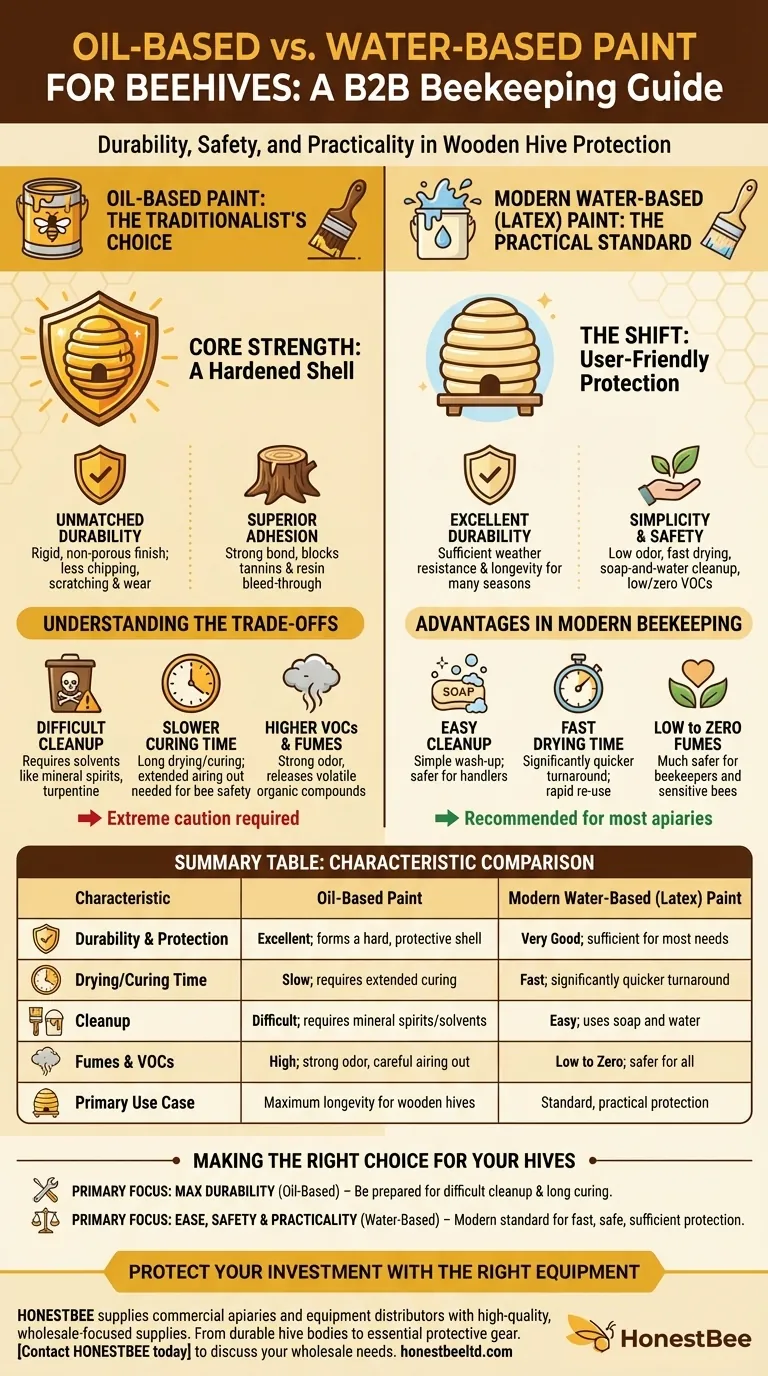In essence, oil-based paint is characterized by its exceptional toughness and durability, which allows it to form a hard, protective shell on wooden beehives. However, its use has declined in favor of modern water-based paints due to its difficult cleanup, which requires mineral spirits, and slower drying times.
While oil-based paint offers superior wear resistance, the practical advantages of high-quality water-based (latex) paints—namely easier cleanup and lower fumes—have made them the more common and recommended choice for most beekeepers today.

The Core Strength: A Hardened Shell
The primary reason beekeepers have traditionally used oil-based paint is its ability to create a highly resistant barrier against the elements. This translates to direct benefits for hive longevity.
Unmatched Durability
Oil-based formulas cure into a rigid, non-porous finish. This hard shell is less susceptible to chipping, scratching, and the general wear that comes from moving and managing hive components.
Superior Adhesion on Raw Wood
This type of paint excels at adhering to wood, especially resinous or acidic types like cypress or pine. It forms a powerful bond that effectively blocks tannins and wood resins from bleeding through and discoloring the finish.
Understanding the Trade-offs
The durability of oil-based paint comes with significant practical disadvantages that are critical to consider, especially in a beekeeping context.
Difficult Cleanup
Unlike water-based paints, oil-based paint cannot be cleaned with soap and water. Brushes, spills, and hands require harsh solvents like mineral spirits or turpentine, which adds complexity and fumes to the process.
Slower Curing Time
Oil-based paint takes significantly longer to dry and, more importantly, to fully cure. A painted hive must be allowed to air out for an extended period until it is completely free of any chemical odor before it can be safely used for bees.
Higher VOCs and Stronger Fumes
These paints release a higher level of Volatile Organic Compounds (VOCs) as they dry. The strong, lingering odor is a key reason beekeepers must exercise extreme caution, ensuring the equipment is fully cured and odor-free far away from any active hives.
The Shift to Water-Based Alternatives
The reference points are correct: many beekeepers have moved away from oil-based formulas. This is not because oil paint is ineffective, but because modern alternatives have become "good enough" while being far more user-friendly.
The Rise of Quality Latex
Modern exterior water-based (latex) paints offer excellent weather resistance and durability that is more than sufficient for protecting a beehive through many seasons.
Simplicity and Safety
Latex paint's key advantages are its low odor, fast drying time, and simple soap-and-water cleanup. Low- or zero-VOC formulas are widely available, providing a greater margin of safety for you and your bees.
Making the Right Choice for Your Hives
Your decision should be based on how you weigh durability against practical application and safety.
- If your primary focus is absolute maximum durability: Oil-based paint provides the hardest, most wear-resistant finish, but you must be prepared for a difficult cleanup and a very long curing time to ensure bee safety.
- If your primary focus is ease, safety, and practicality: A high-quality exterior water-based latex paint is the modern standard, offering sufficient protection with a much faster and safer application process.
Choosing the right paint means balancing the ideal protection for your woodware with the practical realities of your workload and the well-being of your bees.
Summary Table:
| Characteristic | Oil-Based Paint | Modern Water-Based (Latex) Paint |
|---|---|---|
| Durability & Protection | Excellent; forms a hard, protective shell | Very Good; sufficient for most beekeeping needs |
| Drying/Curing Time | Slow; requires extended curing before bee use | Fast; significantly quicker turnaround |
| Cleanup | Difficult; requires mineral spirits or solvents | Easy; uses soap and water |
| Fumes & VOCs | High; strong odor, requires careful airing out | Low to Zero; safer for beekeeper and bees |
| Primary Use Case | Maximum longevity for wooden hives | Standard, practical protection for most apiaries |
Protect Your Investment with the Right Equipment
Choosing the correct paint is just one part of maintaining a healthy, productive apiary. Equip your operation with durable, purpose-built supplies that stand up to the elements and the demands of commercial beekeeping.
HONESTBEE supplies commercial apiaries and beekeeping equipment distributors with high-quality, wholesale-focused supplies. From durable hive bodies and frames to essential protective gear and tools, we provide the reliable equipment you need to succeed.
Contact HONESTBEE today to discuss your wholesale needs and ensure your apiary is built to last.
Visual Guide

Related Products
- Wholesales Dadant Size Wooden Bee Hives for Beekeeping
- Long Langstroth Style Horizontal Top Bar Hive for Wholesale
- Professional Insulated Winter Hive Wrap for Beekeeping
- Automatic Honey Flow Beehive 4 Frame Mini Hive for Beekeeping
- Langstroth Bee Hives Bee Keeping Box for Beginners Beekeeping
People Also Ask
- What is beekeeping equipment? Essential Tools for Commercial Apiaries & Distributors
- Why were wooden hives traditionally preferred? For Natural Beekeeping Aligned with Bee Biology
- What are the essential pieces of equipment for most beekeepers? Get Started with the Right Gear
- What should beginners consider when purchasing beekeeping equipment? A Guide to Essential Starter Gear
- What is the best place to keep bees? Find the Perfect Apiary Site for Your Hives



















